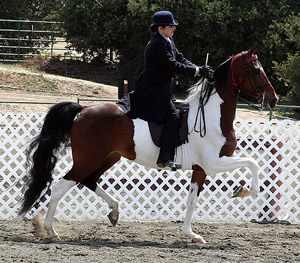History
The Arabian horse has been called "a living work of art" and the American Saddlebred has been termed "the peacock of the show ring." The combination of these two dynamic breeds, each with its own inimitable qualities, has produced a horse called the National Show Horse, an animal that truly combines the grace and beauty of the Arabian with the show ring charisma of the Saddlebred.
The National Show Horse, as a show ring winner, had existed without a specific name or promotion for many years. There was a select group of horsemen and women in the early 1980s who believed that because of its consistent show ring success, combined with its athletic ability, beauty, endurance, attitude and heart, this Arabian-Saddlebred combination deserved a name and an organization to promote it. As a result, The National Show Horse burst on the scene in 1982 with more than just a name, it brought with it the first prize money system that would make it financially rewarding for exhibitors to show their horses. In its first National ChampioNational Show Horseip Finals competition in 1984, the National Show Horse Registry paid out more than $100,000 in prize money.
After its official beginning in 1982, the National Show Horse Registry allowed a period of open registration in order to collect a pool of horses that would be the foundation of the new breed. Today, the registry has established specific rules regarding the types of horses that may be used to produce National Show Horses. Three types of stallions and three types of mares can produce acceptable National Show Horse offspring -- Arabian, Saddlebred and National Show Horse. Both mares and stallions must be registered with their appropriate breed registries. Arabian and Saddlebred stallions, however, must also be nominated and approved by the National Show HorseR board of directors. Any combination of the above three breeds of horse may be utilized for National Show Horse production as long as the resultant foal meets the blood content requirements ranging from 25 percent Arabian blood to 99 percent Arabian blood.
Behavior
N/A
Function
The National Show Horse is most often used for saddle seat riding. They are horses with high-stepping action and can be trained to move with a very elevated front end. Some can be trained to be five-gaited, adding the slow gait and rack to the traditional gaits of the walk, trot and canter. A versatile breed, they can also be used for show jumping, endurance, dressage, or western riding.






